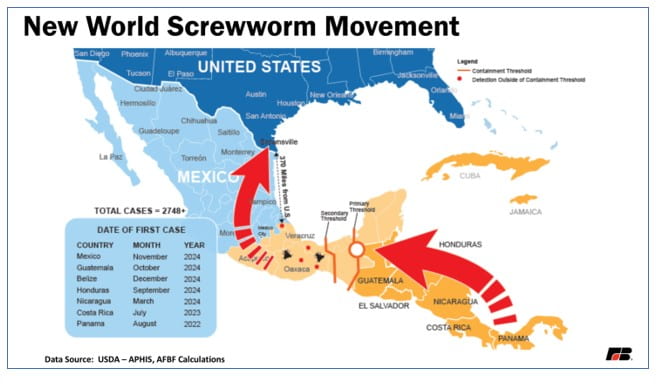- Tweet
- Printer Friendly
New world Screwworm Moves North Adding to Market Volatility
Bernt Nelson, Economist, American Farm Bureau Federation
New detections of new world screwworm (NWS) in Mexico led Sec. Brooke Rollins to close Southern ports of entry to livestock imports. USDA had previously announced a phased re-opening of Southern ports, beginning with the furthest port away from where NWS has been detected in Mexico and moving East as continued progress is made on sterile fly production. However, the re-opening was halted, and livestock imports once again paused, when NWS was detected 160 miles North of the sterile fly dispersal locations in Veracruz, Mexico–only 370 miles from the U.S. border.

An isolated outbreak of NWS occurred in Texas in 1976 resulting in about $330 million in losses. A recent ERS study evaluated what it might look like if NWS would reach Texas now. According to the study, after adjusting for inflation, market conditions, etc. the impact would be around $1.9 billion. This study did not account for the record setting prices in 2025 along with some other market changes which means the impact could be greater.
One question being asked is how much of an impact will the Southern port closures have on markets? The U.S. imports 1.2-1.5 million head of cattle from Mexico every year. These are mostly feeder cattle destined for feedlots and ultimately beef production. U.S. cattle slaughter was about 31.9 million head in 2024. In terms of production, 1.5 million head would be about 4% of 2024 slaughter. This is a significant portion of the market and while other fundamental factors like strong demand are currently having a bigger impact, this drop in supply will put upward pressure on cattle prices. According to USDA’s latest WASDE report, 2025 production is forecast down 170 million pounds due to smaller production for the second half of the year. Higher feedlot placements are expected in the second half of 2025, leading USDA to increase 2026 production by 540 million pounds or 2% from last month to 25.815 billion pounds. This forecast assumes that cattle imports from Mexico will remain banned for the remainder of the forecast period.
Source: American Farm Bureau Federation